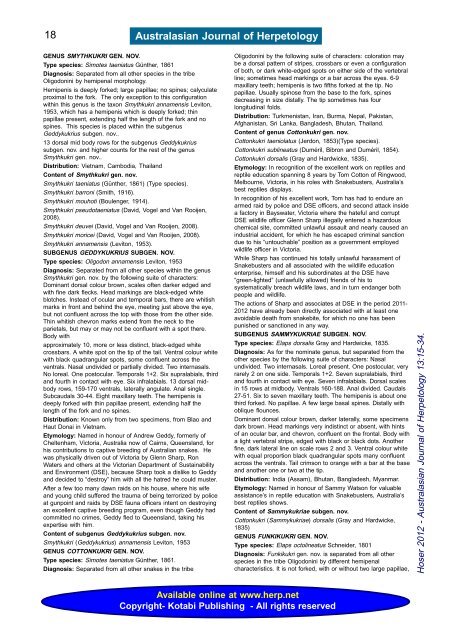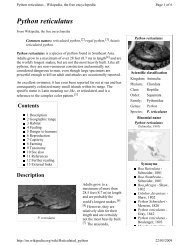Issue Thirteen 30 June 2012 - Taxonomic issue - all - Smuggled.com
Issue Thirteen 30 June 2012 - Taxonomic issue - all - Smuggled.com
Issue Thirteen 30 June 2012 - Taxonomic issue - all - Smuggled.com
Create successful ePaper yourself
Turn your PDF publications into a flip-book with our unique Google optimized e-Paper software.
18<br />
GENUS SMYTHKUKRI GEN. NOV.<br />
Type species: Simotes taeniatus Günther, 1861<br />
Diagnosis: Separated from <strong>all</strong> other species in the tribe<br />
Oligodonini by hemipenal morphology.<br />
Hemipenis is deeply forked; large papillae; no spines; calyculate<br />
proximal to the fork. The only exception to this configuration<br />
within this genus is the taxon Smythkukri annamensis Leviton,<br />
1953, which has a hemipenis which is deeply forked; thin<br />
papillae present, extending half the length of the fork and no<br />
spines. This species is placed within the subgenus<br />
Geddykukrius subgen. nov..<br />
13 dorsal mid body rows for the subgenus Geddykukrius<br />
subgen. nov. and higher counts for the rest of the genus<br />
Smythkukri gen. nov..<br />
Distribution: Vietnam, Cambodia, Thailand<br />
Content of Smythkukri gen. nov.<br />
Smythkukri taeniatus (Günther, 1861) (Type species).<br />
Smythkukri barroni (Smith, 1916).<br />
Smythkukri mouhoti (Boulenger, 1914).<br />
Smythkukri pseudotaeniatus (David, Vogel and Van Rooijen,<br />
2008).<br />
Smythkukri deuvei (David, Vogel and Van Rooijen, 2008).<br />
Smythkukri moricei (David, Vogel and Van Rooijen, 2008).<br />
Smythkukri annamensis (Leviton, 1953).<br />
SUBGENUS GEDDYKUKRIUS SUBGEN. NOV.<br />
Type species: Oligodon annamensis Leviton, 1953<br />
Diagnosis: Separated from <strong>all</strong> other species within the genus<br />
Smythkukri gen. nov. by the following suite of characters:<br />
Dominant dorsal colour brown, scales often darker edged and<br />
with fine dark flecks. Head markings are black-edged white<br />
blotches. Instead of ocular and temporal bars, there are whitish<br />
marks in front and behind the eye, meeting just above the eye,<br />
but not confluent across the top with those from the other side.<br />
Thin whitish chevron marks extend from the neck to the<br />
parietals, but may or may not be confluent with a spot there.<br />
Body with<br />
approximately 10, more or less distinct, black-edged white<br />
crossbars. A white spot on the tip of the tail. Ventral colour white<br />
with black quadrangular spots, some confluent across the<br />
ventrals. Nasal undivided or parti<strong>all</strong>y divided. Two internasals.<br />
No loreal. One postocular. Temporals 1+2. Six supralabials, third<br />
and fourth in contact with eye. Six infralabials. 13 dorsal midbody<br />
rows, 159-170 ventrals, later<strong>all</strong>y angulate. Anal single.<br />
Subcaudals <strong>30</strong>-44. Eight maxillary teeth. The hemipenis is<br />
deeply forked with thin papillae present, extending half the<br />
length of the fork and no spines.<br />
Distribution: Known only from two specimens, from Blao and<br />
Haut Donai in Vietnam.<br />
Etymology: Named in honour of Andrew Geddy, formerly of<br />
Cheltenham, Victoria, Australia now of Cairns, Queensland, for<br />
his contributions to captive breeding of Australian snakes. He<br />
was physic<strong>all</strong>y driven out of Victoria by Glenn Sharp, Ron<br />
Waters and others at the Victorian Department of Sustainability<br />
and Environment (DSE), because Sharp took a dislike to Geddy<br />
and decided to “destroy” him with <strong>all</strong> the hatred he could muster.<br />
After a few too many dawn raids on his house, where his wife<br />
and young child suffered the trauma of being terrorized by police<br />
at gunpoint and raids by DSE fauna officers intent on destroying<br />
an excellent captive breeding program, even though Geddy had<br />
<strong>com</strong>mitted no crimes, Geddy fled to Queensland, taking his<br />
expertise with him.<br />
Content of subgenus Geddykukrius subgen. nov.<br />
Smythkukri (Geddykukrius) annamensis Leviton, 1953<br />
GENUS COTTONKUKRI GEN. NOV.<br />
Type species: Simotes taeniatus Günther, 1861.<br />
Diagnosis: Separated from <strong>all</strong> other snakes in the tribe<br />
Australasian Journal of Herpetology<br />
Oligodonini by the following suite of characters: coloration may<br />
be a dorsal pattern of stripes, crossbars or even a configuration<br />
of both, or dark white-edged spots on either side of the vertebral<br />
line; sometimes head markings or a bar across the eyes. 6-9<br />
maxillary teeth; hemipenis is two fifths forked at the tip. No<br />
papillae. Usu<strong>all</strong>y spinose from the base to the fork, spines<br />
decreasing in size dist<strong>all</strong>y. The tip sometimes has four<br />
longitudinal folds.<br />
Distribution: Turkmenistan, Iran, Burma, Nepal, Pakistan,<br />
Afghanistan, Sri Lanka, Bangladesh, Bhutan, Thailand.<br />
Content of genus Cottonkukri gen. nov.<br />
Cottonkukri taeniolatus (Jerdon, 1853)(Type species).<br />
Cottonkukri sublineatus (Duméril, Bibron and Duméril, 1854).<br />
Cottonkukri dorsalis (Gray and Hardwicke, 1835).<br />
Etymology: In recognition of the excellent work on reptiles and<br />
reptile education spanning 8 years by Tom Cotton of Ringwood,<br />
Melbourne, Victoria, in his roles with Snakebusters, Australia’s<br />
best reptiles displays.<br />
In recognition of his excellent work, Tom has had to endure an<br />
armed raid by police and DSE officers, and second attack inside<br />
a factory in Bayswater, Victoria where the hateful and corrupt<br />
DSE wildlife officer Glenn Sharp illeg<strong>all</strong>y entered a hazardous<br />
chemical site, <strong>com</strong>mitted unlawful assault and nearly caused an<br />
industrial accident, for which he has escaped criminal sanction<br />
due to his “untouchable” position as a government employed<br />
wildlife officer in Victoria.<br />
While Sharp has continued his tot<strong>all</strong>y unlawful harassment of<br />
Snakebusters and <strong>all</strong> associated with the wildlife education<br />
enterprise, himself and his subordinates at the DSE have<br />
“green-lighted” (unlawfully <strong>all</strong>owed) friends of his to<br />
systematic<strong>all</strong>y breach wildlife laws, and in turn endanger both<br />
people and wildlife.<br />
The actions of Sharp and associates at DSE in the period 2011-<br />
<strong>2012</strong> have already been directly associated with at least one<br />
avoidable death from snakebite, for which no one has been<br />
punished or sanctioned in any way.<br />
SUBGENUS SAMMYKUKRIAE SUBGEN. NOV.<br />
Type species: Elaps dorsalis Gray and Hardwicke, 1835.<br />
Diagnosis: As for the nominate genus, but separated from the<br />
other species by the following suite of characters: Nasal<br />
undivided. Two internasals. Loreal present. One postocular, very<br />
rarely 2 on one side. Temporals 1+2. Seven supralabials, third<br />
and fourth in contact with eye. Seven infralabials. Dorsal scales<br />
in 15 rows at midbody. Ventrals 160-188. Anal divided. Caudals<br />
27-51. Six to seven maxillary teeth. The hemipenis is about one<br />
third forked. No papillae. A few large basal spines. Dist<strong>all</strong>y with<br />
oblique flounces.<br />
Dominant dorsal colour brown, darker later<strong>all</strong>y, some specimens<br />
dark brown. Head markings very indistinct or absent, with hints<br />
of an ocular bar, and chevron, confluent on the frontal. Body with<br />
a light vertebral stripe, edged with black or black dots. Another<br />
fine, dark lateral line on scale rows 2 and 3. Ventral colour white<br />
with equal proportion black quadrangular spots many confluent<br />
across the ventrals. Tail crimson to orange with a bar at the base<br />
and another one or two at the tip.<br />
Distribution: India (Assam), Bhutan, Bangladesh, Myanmar.<br />
Etymology: Named in honour of Sammy Watson for valuable<br />
assistance’s in reptile education with Snakebusters, Australia’s<br />
best reptiles shows.<br />
Content of Sammykukriae subgen. nov.<br />
Cottonkukri (Sammykukriae) dorsalis (Gray and Hardwicke,<br />
1835)<br />
GENUS FUNKIKUKRI GEN. NOV.<br />
Type species: Elaps octolineatus Schneider, 1801<br />
Diagnosis: Funkikukri gen. nov. is separated from <strong>all</strong> other<br />
species in the tribe Oligodonini by different hemipenal<br />
characteristics. It is not forked, with or without two large papillae,<br />
Available online at www.herp.net<br />
Copyright- Kotabi Publishing - All rights reserved<br />
Hoser <strong>2012</strong> - Australasian Journal of Herpetology 13:15-34.



